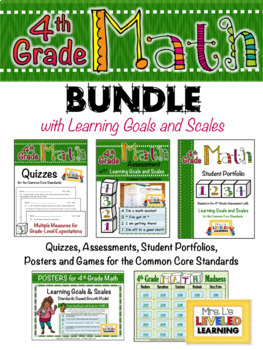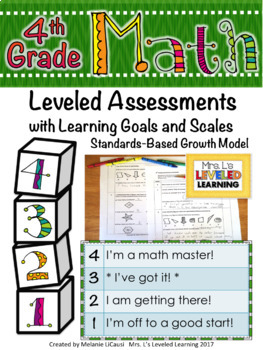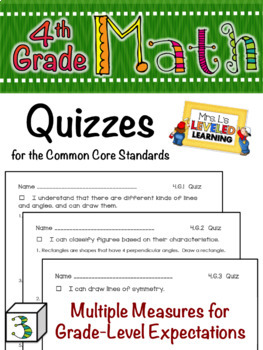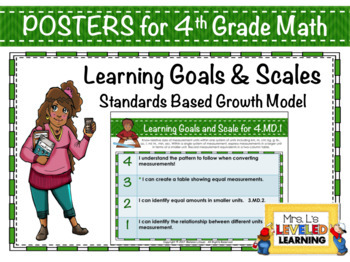4th Grade Math Leveled Assessment BUNDLE for Differentiation Marzano Scale
- Zip
- Easel Activity
What educators are saying
Products in this Bundle (10)
showing 1-5 of 10 products
Bonus
Description
POSTERS:
Learning Goals and Scales are the ultimate Standards Based Grading tool! They don't just motivate a Growth Mindset, they define how students can demonstrate mastery. Every learning standard is broken down into 4 levels of Differentiation. Also known as a scaffold for learning. These Posters lead students up a progressive learning path that mirrors the way they develop concepts. Aligned to Bloom or Marzano Taxonomy of cognitive skills. From easiest-hardest: (Recall/Retrieval, Comprehension, Analysis/Application, and Knowledge Utilization/Synthesis).
4 Learning Goal “I Can” Statements for each standard:
4. Level 4 indicates an advanced knowledge of the skill.
3. Level 3 represents proficiency in each math standard. see the stars*
2. Level 2 will include content from the previous grade level and new vocabulary that must be applied correctly for mastery of level 3.
1. Level 1 will either be derived from sub-skills of the standard, or from the background knowledge of earlier grade levels.
Students review EASY learning goals from previous grade levels in sections, “Levels” 1 and 2. These first two levels set them up to see simple examples of the connections between what they know, and what they must do this year. “Level” 3, or section 3, includes questions they should master this year. “Level” 4 includes optional enrichment tasks for your gifted and talented thinkers.
Need some ideas to quickly modify tasks and engage different learners? Follow this link to get some quick tips for INSTANT DIFFERENTIATION. It take seconds to implement!
How to Use these Posters:
1. Print the ones you are currently planning instruction for. (color/black and white)
*Option: Display them digitally on a white board while you teach!
2. Briefly review levels 1, 2, and 3 (in that order) so your students can access prior knowledge and pre-assess themselves.
3. Refer to the poster while you teach and practice new skills. Students will see their progression.
*Additional Options:
4. Offer examples for each level of the proficiency scale (See Assessments linked below!)
Assessments can be used as pre- and post-tests for students to demonstrate and document mastery and growth.
5. Refer to the levels 1 and 2 to create appropriate modifications for targeted instruction or small group practice.
6. Use Level 4 to modify or create enrichment tasks for your gifted and talented students.
Assessments:
Proficiency Scales are the ultimate Standards Based Grading tool! They don't just motivate a Growth Mindset, they define how students can demonstrate mastery. Every learning standard is broken down into 4 levels of Differentiation. These Posters lead students up a progressive learning path that mirrors the way they develop concepts. Aligned to Bloom’s or Marzano’s Taxonomy of cognitive skills. From easiest-hardest: (Recall/Retrieval, Comprehension, Analysis/Application, and Knowledge Utilization/Synthesis).
4 Learning Goal “I Can” Statements for each standard:
4. Level 4 indicates an advanced knowledge of the skill.
3. Level 3 represents proficiency in each math standard. see the stars*
2. Level 2 will include content from the previous grade level and new vocabulary that must be applied correctly for mastery of level 3.
1. Level 1 will either be derived from sub-skills of the standard, or from the background knowledge of earlier grade levels.
Students review EASY learning goals from previous grade levels in sections, “Levels” 1 and 2. These first two levels set them up to see simple examples of the connections between what they know, and what they must do this year. “Level” 3, or section 3, includes questions they should master this year. “Level” 4 includes optional enrichment tasks for your gifted and talented thinkers.
How to Use these Assessments:
1. Print the standards you are currently planning to teach.
(Tasks for Levels 1 -4 fit on a single sheet of paper, two-sided.)
2. You may briefly review the standard and levels 1, 2, and 3 (in that order) so your students can access prior knowledge and pre-assess themselves. OR give it cold and see how they do as a pre-assessment.
3. Correct the pre-assessment, and share students’ results with them. Emphasize that this is NOT for a grade, but just to identify a starting place.
4. Use their scores to plan instruction, practice, review, small groups, or homework for your levels. (Sometimes I combine 3-4 and 1-2, so there are only two groups to differentiate for.)
5. Use the SAME Assessment sheet as a post-test!
Students will see their progress concretely! They should be allowed to correct old mistakes, and complete as many levels as possible to show mastery.
6. Record their final level in your gradebook.
7. Save the assessment in a portfolio folder to document student progress.
These are handy for parent conferences and teacher evaluations.
Need something simpler? Get Just the BASICS BUNDLE HERE.
**UPDATED Feature: What does EDITABLE mean? This newest version (2107) offers COMPLETELY EDITABLE TEXT for levels 3 and 4. This includes the Learning Goal statements AND the test problems on every Assessment page for levels 3 and 4.
Please re-download from your "My Purchases" page if you already own this license.
You can revise them to match the EDITABLE Posters with Marzano Learning Goals and Scales. (See link to grade-level Posters below.) Whether your district requires specific phrasing for each scale, or your State standards are slightly modified from the original Common Core language, you will be able to adjust the goal statements and test questions for levels 3 and 4 of the Assessment. The content for Levels 1 and 2 will remain the same to ensure an accurate progression of skills and copyright. Visit this blog post for examples and directions. EDITABLE MATH ASSESSMENTS
Editable Posters with Learning Goals and Scales
Click here to see a video of How to Teach a 4th Grade Math Scale.
Visit my blog for examples of student work, explanations, and tips on grading the assessment using the 4-point scale.
Mrs. L's Leveled Learning LLC
www.mrslsleveledlearning.com
Copyright 2018 by Melanie LiCausi; Mrs. L’s Leveled Learning LLC
Purchasing this resource allows one teacher the right to reproduce materials for his/her own classroom. To share with other, please purchase additional licenses at a discount from your "My Purchases" page. Uploading resources to the internet in any form, for free or for purchase is also a misuse of copyright. EDITABLE content MAY NOT be used to create new products for free or for profit. If you are a coach, principal or district interested in purchasing several licenses, please contact me for a district-wide quote. Thank you for your consideration! melanie.licausi@mrslsleveledlearning.com
*This Bundle may be revised at any time, with new materials and different pricing. Once you have purchased the Bundle, you will always have access to revisions for free. Simply re-download the Bundle from your “My Purchases” page anytime you receive a notice about updates. Click “Follow Me” to receive notices in your TpT inbox. Follow me online at www.mrslsleveledlearning.com
Follow the links below to download a FREE PREVIEW for each document included.
Math Bundle Preview Video - EDITABLE Learning Goals and Scales





